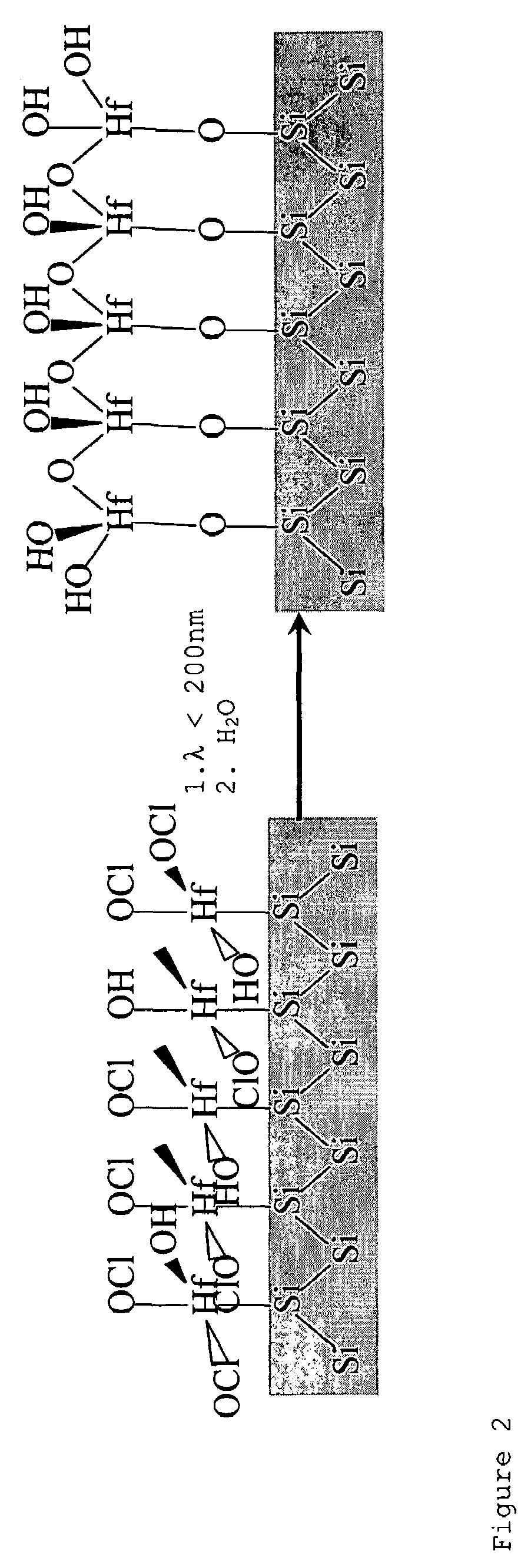Atomic layer deposition method for depositing a layer
a layer and atomic layer technology, applied in chemical vapor deposition coatings, electrical devices, coatings, etc., can solve the problems of poor interface quality, difficult control of interface quality, poor chemical and electrical properties, etc., and achieve the effect of improving the chemical and electrical characteristics of the deposited layer
- Summary
- Abstract
- Description
- Claims
- Application Information
AI Technical Summary
Benefits of technology
Problems solved by technology
Method used
Image
Examples
example 1
[0099]As a first example of the invention, the ALD of hafnium chloride is performed at lower temperatures (than usually performed), in the range of 150° C.-220° C. (FIG. 1).
[0100]At these temperatures, the Si surface has a significantly higher concentration of surface hydroxyls than under the conventional deposition temperature of 300° C.
[0101]However, the lower temperature has the negative side effect of not driving the HfCl4 reaction to completion.
[0102]The resulting species has some concentration of—OCl termination of the Hf instead of the more desirable—OH termination.
[0103]So, although the growth rate of the ALD can be nearly a monolayer (˜0.2 nm) per cycle, the defects introduced by the OCl terminations will make for a poor quality layer.
[0104]Additionally, it is difficult to remove the residual Cl out of the layers through post deposition anneals.
[0105]When treating (exposing) the semiconductor substrate with UV in the first one to five cycles, dissociation of HfCl4 is increa...
example 2
[0112]As a second example of the invention, the ALD starts with the conventional process at 300° C. but in this case the Si surface looks significantly different.
[0113]FIG. 3 shows a schematic of the Si surface at 300° C. One can clearly see the difference compared to the starting surface in FIG. 1.
[0114]With this high temperature, adjacent hydroxyls react as shown in FIG. 4, leaving few isolated OH groups.
[0115]This dramatically reduces the surface coverage in the first few cycles of the ALD process.
[0116]In FIG. 5A-C, possible starting surface compositions following 1-3 cycles of HfCl4 and H2O are illustrated. After UV treatment (FIG. 5D) the surface coverage is increased dramatically.
example 3
[0117]An ALD deposition is done on a silicon semiconductor substrate, starting from HCl4 as first precursor and H2O as second precursor.
[0118]Between the HCl4 pulse and the H2O pulse an inert atmosphere is provided by purging the reactor with nitrogen.
[0119]A nitrogen purge is also done after the H2O pulse.
[0120]A spot of about 40 mm width on the silicon substrate is then exposed to a 172 nm UV irradiation during one of the two nitrogen purges.
[0121]In FIG. 6, the difference in layer thickness measured by ellipsometry between the substrate surface exposed to UV irradiation and the substrate surface not exposed to UV irradiation is shown.
[0122]The triangles (▴) show the layer thickness after 10 cycles of conventional ALD without UV exposure.
[0123]The dots (●) show the layer thickness after 10 cycles of conventional ALD deposition, followed by 3 min UV exposure as a post-deposition treatment.
[0124]The diamonds (♦) show the layer thickness after 10 cycles of ALD including in each cycle...
PUM
| Property | Measurement | Unit |
|---|---|---|
| wavelength | aaaaa | aaaaa |
| wavelength | aaaaa | aaaaa |
| wavelength | aaaaa | aaaaa |
Abstract
Description
Claims
Application Information
 Login to View More
Login to View More - R&D
- Intellectual Property
- Life Sciences
- Materials
- Tech Scout
- Unparalleled Data Quality
- Higher Quality Content
- 60% Fewer Hallucinations
Browse by: Latest US Patents, China's latest patents, Technical Efficacy Thesaurus, Application Domain, Technology Topic, Popular Technical Reports.
© 2025 PatSnap. All rights reserved.Legal|Privacy policy|Modern Slavery Act Transparency Statement|Sitemap|About US| Contact US: help@patsnap.com



